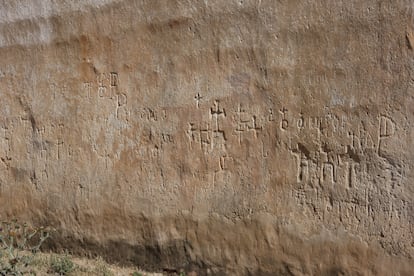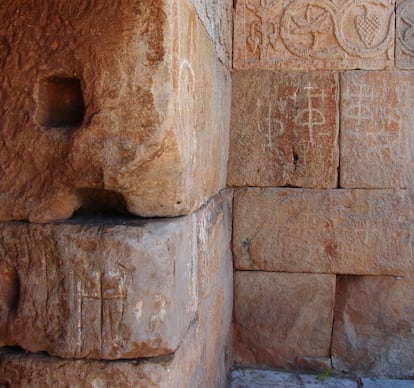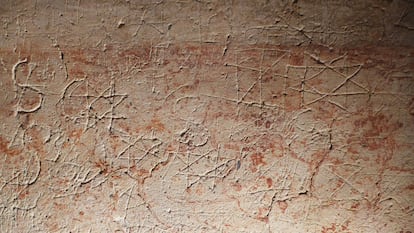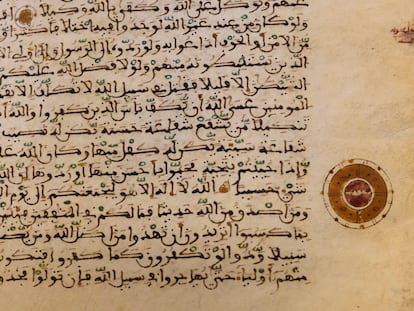The invisible language of the Romanesque walls that is struggling to survive modern restoration work
A recent study has analyzed, classified, and called for crosses, stars, and other symbols that our ancestors carved into the walls of medieval buildings to be saved ‘from the pickaxe’

“We don’t really look at them, but they are there.” Without context, the sentence could refer to any everyday item. Although when he says it, the researcher Josemi Lorenzo is referring to the amount of writings, symbols, and signs that have accumulated on the walls of dozens of Romanesque churches that he has analyzed — most of them located in rural Castilla y León (Spain) — and that usually go unnoticed. What is the meaning of the crosses, stars with different numbers of points, or filigrees such as the interlacings that have been preserved on the walls for centuries? It is known that they were made by people of all social classes and levels of knowledge, and that they appeared spontaneously, without any prior planning. With regard to their meaning, the author of the study points, mainly, to the ancestral will of humans to ward off evil. They may also be interpreted as an ex-voto, that is, in gratitude to the divinity for favors received.
But beyond the generalities, the details of this intriguing custom are even more fascinating today than the various — although hackneyed and recurring — interpretations of the iconography present on Romanesque portals, capitals, and tympanums. “My personal experience is that if you talk to people about psychostasis (the weighing of souls), you start to see them yawning. On the other hand, when you show them graffiti on a church wall, their interest skyrockets,” the historian Josemi Lorenzo reveals. Perhaps it was this same appeal that led him to study, analyze, and define what he himself calls “scrawls”: graffiti on the walls of churches that continue to battle for survival, and that represent a true library for historians to extract data on the people of the past.

That is, they are a kind of language — or means of expression — of the everyday folk. This is the key to research, and its value lies specifically in them. The buildings raised by the master builders of the Middle Ages are well understood. We appreciate the work of the sculptors who carved the stone, and the painters who decorated the walls. However, what do we know about the humble, illiterate people? “If the graffiti is textual, its authors belong to a very specific segment of society, the cult. A cross made up of two lines, on the other hand, can be made by anyone,” Lorenzo writes in Mágico y sobrenatural. Creencias y supersticiones en la época del románico [Magical and supernatural. Beliefs and superstitions in the Romanesque period]. And they were also community testimonies. “You can place a fig on a child (an amulet to rid children of the evil eye), a coral, or a cross, but a building belongs to the people, and it is the people who protect it and make it their own through this type of devotion,” the author adds. In doing so, he is referring to a whole range of drawings recorded on walls, door jambs, and lintels: from crosses and stars to intertwining knots, mazes, and alquerque (the board game) designs that imitate the popular tic-tac-toe board.
They grow and multiply
In view of the impressive north wall of the hermitage of San Miguel, in the town of Gormaz, in Spain, it is worth adding one more characteristic to this enigmatic language: the rayajos [scrawls] seem to grow and multiply, crowding the entire wall. In any case, the symbols are far from the definition of a palimpsest — a text written on top of a previous inscription — since its lines never overlap or disturb each other. “There is a kind of code, some respect each other, as in contemporary graffiti,” explains Lorenzo Arribas. Why are there so many? This is easier to understand. If a simple cross serves to ward off evils such as epidemics, poor harvests, or collective misfortunes, the more they appear juxtaposed together, the greater their protection against evil; their power “intensifies.”
Hence, our ancestors placed this type of symbol on thresholds and windows, that is, in all those cracks that the devil could slip through. “In Western culture, evil enters through the openings or through the roof, which is why we can also find marks on the tiles. For the Maghrebi Muslim culture, on the other hand, evil gains access through food, which is why there are a multitude of plates and bowls marked with the protective symbol of the hand of Fatima,” Josemi Lorenzo specifies.

Together with the interesting hermitage, Lorenzo’s research returns again and again to the enigmatic 10th-century church of Santiago de Peñalba (Peñalba de Santiago, León). Although its mass historical graffiti was not written by contemporary members of the general public — many of them are learned inscriptions made by monks — the religious building contains very rare examples. One such example is the old stone reused as a lintel on the south wall, which contains signs that predate the building’s construction, as well as “a couple of later crosses”. The Mozarabic building exemplifies, like no other, the inability of modern society to decipher these symbols. Experts point out that religious iconography was sometimes difficult for ordinary people to interpret. It was much easier to understand the meaning of the crosses or the five, six, and eight pointed stars, like the ones that the church preserves on one of the walls of the old choir. “It’s today that we don’t understand them,” Lorenzo points out. In fact, this practice has been extinct for centuries.
A crusade against destruction
The case of the church at Bierzo also serves to speak of the never-ending horses’ work undertaken by historians and architects who are concerned about the conservation of these vestiges: preventing restoration processes from obliterating the inscriptions. Not always successfully. Horses’ work because it was the drawing of such an animal on one of the walls of Santiago de Peñalba — which Josemi Lorenzo was proud to show and explain to visitors — that was one of the most recent carvings to disappear due to terrible neglect. “In the late summer 2019, how terrified the little horse must have seen, how the pickaxe shattered this secular art, with scant regard for the legislation for the protection of cultural heritage, nor the defensive plastering, nor its own integrity,” the historian wrote then, not without sadness and indignation.

Here is the ultimate paradox of the innocent graffiti. Even if it is only from a human point of view, of beliefs, it is still perverse that in order to protect a building, the restorations of our time take away the plaster on the walls where the people of the past drew crosses and stars, specifically to safeguard it from evil. The most serious thing is that it is no longer just a question of spontaneous interventions — such as the botched, amateur restoration of the Ecce Homo painting at Borja (Aragón, Spain) — but also of professional restorations. In this case, “one of the possible causes of the error is the lack of supervision from the optional management of the work,” argues Josemi Lorenzo.
What seems even more sinister, though, is confusing centuries-old graffiti with the despicable acts of vandalism of our days. “They tend to be destroyed, when I think they are very important, because it is the people who have made them: they are historical testimonies of social layers that we do not usually have the opportunity to record,” he argues. The guardians of this type of relic are not many, but historians like Lorenzo tell people the story behind them — as in the fateful case of the “little horse” at Peñalba — to make them visible and avoid them being condemned to destruction.
Sign up for our weekly newsletter to get more English-language news coverage from EL PAÍS USA Edition
Tu suscripción se está usando en otro dispositivo
¿Quieres añadir otro usuario a tu suscripción?
Si continúas leyendo en este dispositivo, no se podrá leer en el otro.
FlechaTu suscripción se está usando en otro dispositivo y solo puedes acceder a EL PAÍS desde un dispositivo a la vez.
Si quieres compartir tu cuenta, cambia tu suscripción a la modalidad Premium, así podrás añadir otro usuario. Cada uno accederá con su propia cuenta de email, lo que os permitirá personalizar vuestra experiencia en EL PAÍS.
¿Tienes una suscripción de empresa? Accede aquí para contratar más cuentas.
En el caso de no saber quién está usando tu cuenta, te recomendamos cambiar tu contraseña aquí.
Si decides continuar compartiendo tu cuenta, este mensaje se mostrará en tu dispositivo y en el de la otra persona que está usando tu cuenta de forma indefinida, afectando a tu experiencia de lectura. Puedes consultar aquí los términos y condiciones de la suscripción digital.
More information
Archived In
Últimas noticias
Most viewed
- Sinaloa Cartel war is taking its toll on Los Chapitos
- Oona Chaplin: ‘I told James Cameron that I was living in a treehouse and starting a permaculture project with a friend’
- Reinhard Genzel, Nobel laureate in physics: ‘One-minute videos will never give you the truth’
- Why the price of coffee has skyrocketed: from Brazilian plantations to specialty coffee houses
- Silver prices are going crazy: This is what’s fueling the rally










































